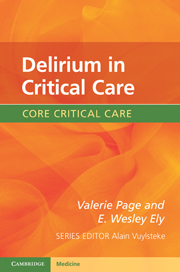Book contents
- Frontmatter
- Contents
- Foreword
- Delirium, a patient testimony
- 1 What is delirium in critical care?
- 2 How common is delirium in critical care?
- 3 What does delirium look like in critical care?
- 4 Delirium in critical care: how does it happen?
- 5 Delirium: what causes it? Risk factors
- 6 Delirium in critical care: why is it important?
- 7 Delirium in critical care: how do we diagnose it?
- 8 How to prevent delirium?
- 9 Treatment of delirium in critical care
- 10 Mental capacity and restraints
- 11 End-of-life care
- 12 What is the future?
- Selected references
- Index
- References
9 - Treatment of delirium in critical care
Published online by Cambridge University Press: 05 December 2011
- Frontmatter
- Contents
- Foreword
- Delirium, a patient testimony
- 1 What is delirium in critical care?
- 2 How common is delirium in critical care?
- 3 What does delirium look like in critical care?
- 4 Delirium in critical care: how does it happen?
- 5 Delirium: what causes it? Risk factors
- 6 Delirium in critical care: why is it important?
- 7 Delirium in critical care: how do we diagnose it?
- 8 How to prevent delirium?
- 9 Treatment of delirium in critical care
- 10 Mental capacity and restraints
- 11 End-of-life care
- 12 What is the future?
- Selected references
- Index
- References
Summary
Introduction
Considering the seriousness of delirium, it is surprising (and frustrating) that the availability of effective pharmacological treatments is limited. This is explained in part by the fact that the pathophysiology is poorly understood – as outlined in Chapter 4. As a clinical syndrome, delirium can be compared to the acute respiratory distress syndrome (ARDS) that has similarly poor outcomes with no magic bullet to make it all better.
Do the drugs used for delirium rectify the neurotransmitter balance or simply alleviate the symptoms? Should we use drugs to treat delirium at all?
As with many conditions in ICU, the most important aspect of treatment is determining and dealing with the cause(s) of the problem. You cannot beat delirium if you do not address all treatable precipitating factors.
Identify and treat the cause
Delirium is always triggered by some ‘event’. It may be a relatively small insult in the vulnerable patient, for instance a new urinary tract infection or a single dose of zopiclone in an elderly patient with pre-existing cognitive impairment. Keep in mind that the two commonest causes of new onset delirium in ICU are infection and drugs. Importantly, remember that simple measures such as restoring oxygenation and blood pressure may be enough to clear delirium in a sick patient. Delirium is a clinical sign not to be ignored!
- Type
- Chapter
- Information
- Delirium in Critical Care , pp. 153 - 179Publisher: Cambridge University PressPrint publication year: 2011

